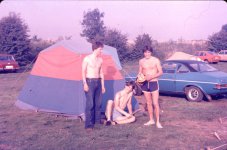you confuse me/
this engine was the 2.3 as fitted to magnums and later bedford cf
blydstein worked on it
where did the v8 bit come from?
In the '60s there were plans to build a couple of small V8s. Initially 3 or 4 litres in capacity. Then along came one of the first of the energy crises so they binned the plan and carried on with their 3.3 litre straight 6 instead. That was a bit sad as it dated back to the '50s so wasn't exactly state of the art. It was considerably older than its arch enemy the Ford Essex V6.I belive they made a v8 ferenza for the South African market. They also raced them over here in the 70's - it was known as Baby Bertha and I bet it sounded awesome
They ended up with 1.6 and 2.0 litre slant 4s which meant they had the block, pistons, con-rods and bottom end of the V8 original. The rally Chevette HS2300s used to put out around 235bhp with pretty much a standard engine from the head gasket down. The pistons would probably have been high compression and made of higher grade steel, but that engine bore far more of a resemblance to the showroom product than, for instance, the Escort RS1600, which became closer and closer to a Cosworth BDA, or even a BDG. The RS1600 later became the RS 1800 which itself ended up with a 2 litre engine despite still being called an 1800.
Most of the earlier rally cars were based around the SOHC 8v head and it was the racing Firenza that pioneered the 16v head, but when it came to competing with Ford, FIAT and the like they had to start homologation procedures and it was here that they nearly came a cropper. If you look at a "normal" twin cam with a 16v head, it sits fairly squarely on top of the engine. But because of its height, the Vauxhall engine was canted over at 45 degrees. If you do that with the Ford motor the head will be pointing at one of the front suspension turrets and for your local Ford dealer, even a Rally Sport dealer, that made working on the head more difficult and therefore more expensive for the customer. Vauxhall's answer was to fit two seperate cam covers and cant them upwards at 45 degrees.
http://i458.photobucket.com/albums/qq309/friendlyfire_photos/camerapics008.jpg
http://classiccarhunter.com/wp-content/uploads/2008/09/vxchevette_engine.jpg
http://www.classicandperformancecar...re_library_UK/dir_987/car_photo_493579_25.jpg
If I've managed to do this correctly there should be 3 pictures here, one of a Magnum type SOHC 8v engine, one of the HS Twin cam 16v and one very similar to mine with twin Webers, or in this case, Dell 'Ortos.
Because of Lotus' alleged use of the Vauxhall 2 litre block for the new Elite in the '70s, there appeared to be a bit of a quid pro quo whereby Vauxhall used a Lotus head design to get their own 16valve but the design, as I said earlier, meant that on the production versions the only way the mechanics at your local dealer could adjust the tappets was to undo all the engine and gearbox mounts and block the motor up in order to clear the suspension turret, which might have meant having to disconnect the cooling system as well. Because of this they stepped the head but, bit naughty this, kept the Lotus style heads for competition. Unfortunately the motor sport authorities took exception to this as it broke homologation rules and Vauxhall had to revert to using their own head design.
Right, my brain hurts so it's time to go to bed.
Last edited:




